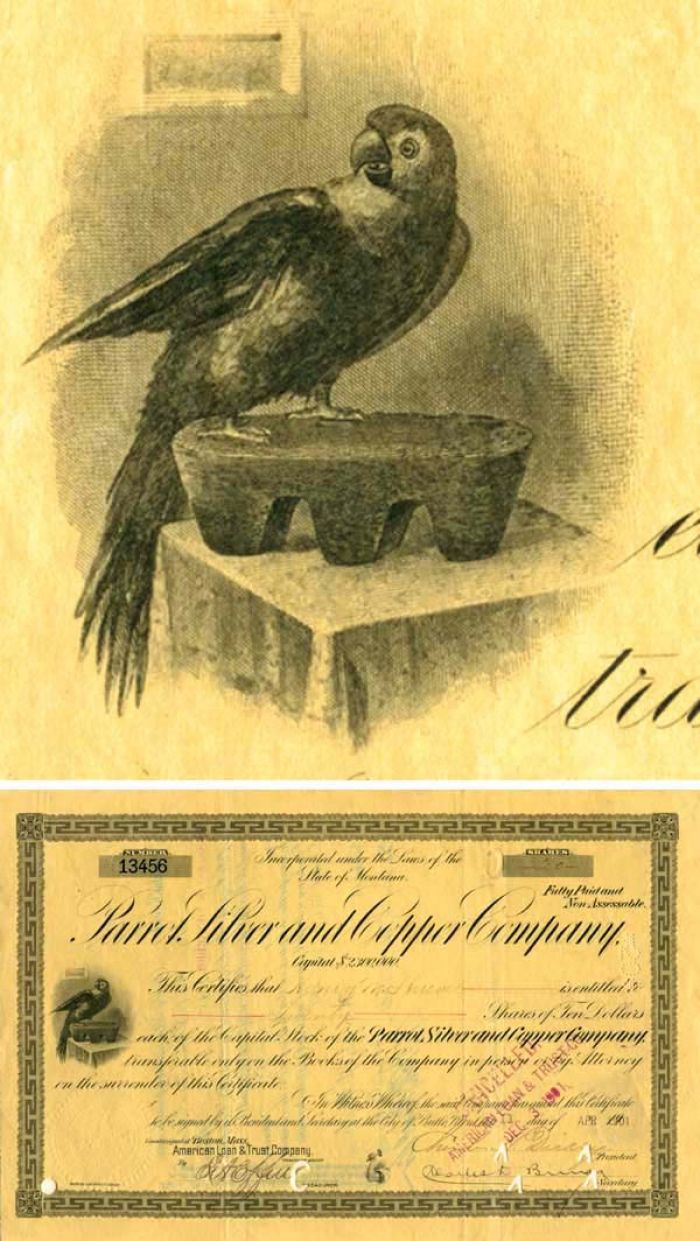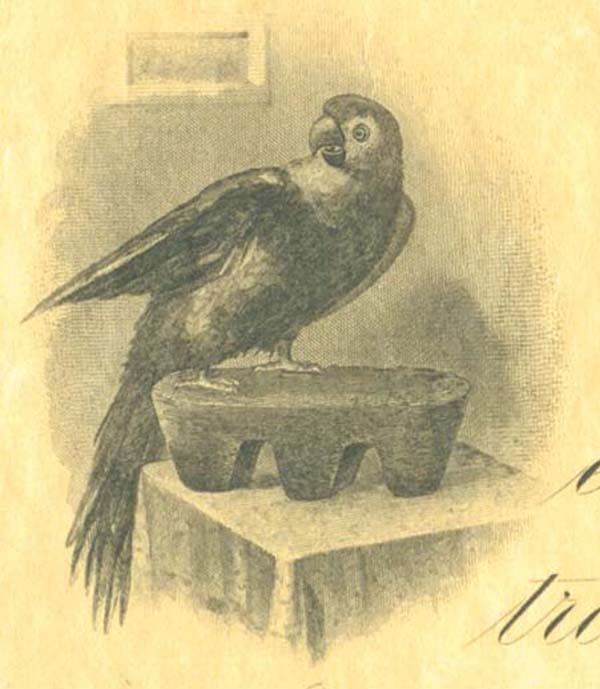Transferred to William Goodsell Rockefeller - Parrot Silver & Copper Co. - Parrot with Ingot Vignette - Montana Mining Stock Certificate
Inv# AG1636 Stock
Stock transferred to William Goodsell Rockefeller but not signed.
William Goodsell Rockefeller (May 21, 1870 – November 30, 1922) was a director of the Consolidated Textile Company and a member of the prominent Rockefeller family.
He was born on May 21, 1870 in Manhattan, New York City. He was the third child of Standard Oil co-founder William Avery Rockefeller Jr. and Almira Geraldine Goodsell, who married in 1864. His uncle was John D. Rockefeller and his paternal grandfather was William Rockefeller Sr.
Rockefeller attended Yale University, where he was a member of Alpha Delta Phi, and graduated in 1892.
Although he was predicted by Thomas W. Lawson to be the future head of Standard Oil, the prediction did not prove true. Following his graduation from Yale, he suffered a serious attack of typhoid fever before entering 26 Broadway. Rockefeller was treasurer of the Standard Oil Company of New York for several years until his retirement in 1911.
He served as a director of the Brooklyn Union Gas Company (of which he was also vice-president), the Inspiration Consolidated Copper Company, the New York Mutual Gas Light Company, the Oregon Short Line Railroad, the Oregon Railroad and Navigation Company, the Union Pacific Railroad, and the Consolidated Textile Company, of which he had only been elected a director shortly before his death in 1922.
On November 21, 1895, Rockefeller married Sarah Elizabeth "Elsie" Stillman (1872–1935), daughter of National City Bank president James Jewett Stillman and Sarah Elizabeth Rumrill. Rockefeller's father had become a large shareholder of the National City Bank and his alliance with the Stillman family was sealed by the marriage of his two sons with two Stillman daughters. Rockefeller's brother, Percy Avery Rockefeller, married Elsie's sister, Isabel Goodrich Stillman. Together, William and Elsie were the parents of four sons and a daughter:
- William Avery Rockefeller III (1896–1973), who married Florence Lincoln (1897–1998), sister of Frederic W. Lincoln IV, in 1918.
- Godfrey Stillman Rockefeller (1899–1983), who married Helen Gratz, brother-in-law of Edward H. Watson.
- James Stillman Rockefeller (1902–2004), who married Nancy Carnegie (1900–1994), a grandniece of Andrew Carnegie.
- John Sterling Rockefeller (1904–1988), who married Paula Watjen.
- Almira Geraldine Rockefeller (1907–1997), who married M. Roy Jackson in 1929. After his death in 1944, she remarried in 1945 to Samuel Weston Scott.
He was a member of the Union Club of the City of New York, the Union League Club, the Metropolitan Club, and the University Club.
William Goodsell Rockefeller died of "double pneumonia" at his home, 292 Madison Avenue in Manhattan, New York City, on November 30, 1922, five months after his father. He was interred at the Rockefeller Mausoleum at Sleepy Hollow Cemetery in Sleepy Hollow, New York.

PARROT SILVER & COPPER CO. MONTANA. Office: Washington & Church Sts., Boston, Mass. Mine office: Butte, Silver Bow Co, Mont. Employs about 400 men. Chas. H. Dickey, president; Chas. D. Bun-age, secretary; John D. Ryan, managing director; Harry A. Galway, superintendent. Organized 1880, under laws of Montana, with capitalization $2,300,000, shares $10 par; issued, $2,298,500. Paid quarterly dividends of 50 cents per share on Sept. 12 and Dec. 12, 1904, l.i-' preceding dividend having been 50 cents, in January, 1902. Held an "annual" meeting June, 1904, this being first for 4 years, owing to injunctions from courts restraining meetings. Is controlled, through stock ownership, by the Amalgamated Copper Co., and like all other Amalgamated sub-companies, is engaged in exceedingly involved, costly and apparently interminable litigation, with the Heinze interests, over ownership of ore bodies.
The following table gives a summary of operations and results for the fiscal years ending June 30: 1903. 1904. Tons of ore extracted 253,284 165,408 Total cost of mining $710,831 $466,375 Total cost of transportation 45,591 29,773 Total cost of reduction 692,266 Paid for labor 771,701 676,629 Paid for machinery and supplies 631,396 330,260 Marketing, refining and seaboard expenses 220,814 29,773 Gross proceeds 2,255,869 1,270,627 Total expenditures 1,669,503 1,036,663 Net proceeds 586,366 233,964 Lands, 19 claims, mainly fractional, area circa 25 acres, well located in the central portion of the Butte district, the Parrot, opened 1884, being one of the pioneer mines of the camp. A barren zone occurs at a depth of about 1,000', but good ore bodies are found below.
The ore averages about 3% copper and carries fair silver and gold values. Properties operated are the Parrot, Bellona, Little Minah and Original No. 6 mines. The Little Minah has a 1,000* two-compartment shaft and is connected underground with the Nipper. The main shaft of the Parrot, about 1,700* deep, has three compartments to the 4th level and 4 compartments below, being connected underground with the Colusa-Parrot, Never Sweat, Nipper tand Original mines. This shaft was retimbered in 1904, and has a steel gallows- frame, 112' high and weighing 125 tons, with a maximum load capacity of 50 tons. The Parrot shaft has a 2,500-h. p. hoist, with 28x96* cylinders, capable of raising 10-ton loads from a depth of 3,000*, hoisting two double- deck cages with 10-ton skips swung under, using a flat steel rope %" thick and 8" wide.
Machinery plant includes an 80-drill Ingersoll-Sergeant air compressor and a 22-drill Rand compressor. Mine buildings are mainly of steel, stone and brick, these including a new engine-house, boiler-house, compressor-house and various shops. The mine has an antiquated smelter, idle since 1900, ores being reduced at the Washoe plant of the Anaconda. Company also owns copper refining works at Bridgeport, Conn., these also being antiquated and idle. Ores are running lower in grade than formerly, like all other Butte mines, and now average about 4% copper, with fair gold and silver values. Production was about 12,500,000 Ibs. fine copper for 1904.
Butte is a city in southwestern Montana established as a mining camp in the 1860s in the northern Rocky Mountains straddling the Continental Divide. Butte became a hotbed for silver and gold mining in its early stages, and grew exponentially upon the advent of electricity in the late-nineteenth century due to the land's large natural stores of copper. In 1888 alone, mining operations in Butte had generated an output of $23 million. The arrival of several magnates in the area around this time, later known as the "Copper Kings," marked the beginning of Butte's establishment as a boomtown.
The city was also the site of various political events relating to is industrial roots and expansive workforce, and was home to strong labor activism and Socialist movements in the early-twentieth century. After numerous mining-related disasters (including the 1917 Speculator Mine disaster the largest hard rock mining disaster in world history), and a steady decline in copper demand, Butte's Anaconda Copper company shifted to open-pit mining in the mid-twentieth century. Over several decades, mining took place at the Berkeley Pit before operations were ceased in 1983. Post-millennium economic forces in Butte have largely centered on technology and the health industry, as well as efforts to preserve the city's historic buildings and cultural sites. In 2002, Butte was one of only twelve towns in America to be named a Distinctive Destination by the National Trust for Historic Preservation.
A stock certificate is issued by businesses, usually companies. A stock is part of the permanent finance of a business. Normally, they are never repaid, and the investor can recover his/her money only by selling to another investor. Most stocks, or also called shares, earn dividends, at the business's discretion, depending on how well it has traded. A stockholder or shareholder is a part-owner of the business that issued the stock certificates.









Ebay ID: labarre_galleries